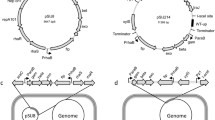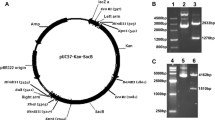Abstract
Most Escherichia coli K12 strains survive for a relatively long time outside the laboratory. Under the same conditions the isoallelic E. coli K12 relA mutants die faster because they lack the stringent response. The killing rate is increased by using a plasmid-encoded suicide system consisting of the phage T7 lysozyme gene driven by the E. coli alkaline phosphatase gene promoter (phoA). Cells containing this system were rapidly and effectively killed as soon as phosphate was made limiting. The combination of the chromosomal relA mutation and a conditional suicide system of this type provides an effective means of biological containment for recombinant E. coli strains.
Similar content being viewed by others
References
Andersson L, Chesbro W, Enfors SO (1993) The stringent response and growth of Escherichia coli in fed batch cultivation. SECOB, Firenze 2:377
Bej AK, Perlin MH, Atlas RM (1989) Model suicide vector for containment of genetically engineered microorganisms. Appl Environ Microbiol 54:2472–2477
Cashel M, Rudd KE (1987) The strigent response. In: Neidhardt FC (ed) Escherichia coli and Salmonella typhimurium. Cellular and molecular biology, vol 2. American Society for Microbiology, Washington DC, pp 1410–1438
Chao WL, Feng RL (1990) Survival of genetically engineered Escherichia coli in natural soil and river water. J Appl Bacteriol 68:319–325
Devanas MA, Rafaeli-Eshkol D, Stotzky G (1986) Survival of plasmid-containing strains of Escherichia coli in soil: effect of plasmid size and nutrients on survival of hosts and maintenance of plasmids. Curr Microbiol 13:269–277
Fill N, Friesen JD (1968) Isolation of “relaxed” mutants of Escherichia coli. J Bacteriol 95:729–731
Gitter B, Diefenbach R, Keweloh H, Riesenberg D (1993) Release of recombinant proteins from stringent and relaxed Escherichia coli cells. Bioengineering 1:70
Hecker M, Schroeter A, Mach F (1983) Replication of pBR322 DNA in stringent and relaxed strains of Escherichia coli. Mol Gen Genet 190:355–357
Hecker M, Schroeter A, Träder K, Mach F (1986) Role of relA mutation in the survival of amino acid-starved Escherichia coli. Arch Microbiol 143:400–402
Hofmann K, Schweder T (1993) Escherichia coli host/plasmid systems providing biological containment. In: Wöhrmann K, Tomiuk J (eds) Transgenic organisms. Risk assessment of deliberate release. Birkhäuser, Basel, pp 193–208
Hofmann K, Schweder T, Reinhardt U, Hecker M (1991) Stability of plasmid pBR322 in Escherichia coli NF161 (relA +) and NF162 (relA) grown in a methionine limited chemostat. Acta Biotechnol 11:403–406
Holzhauer M (1988) Biochemische Labormethoden. Springer, Berlin Heidelberg New York
Inouye M, Arnheim N, Sternglanz R (1973) Bacteriophage T7 lysozyme is an N-acetylmuramyl-l-alanine amidase. J Biol Chem 248:7247–7252
Knudsen SM, Karlström OH (1991) Development of efficient suicide mechanism for biological containment of bacteria. Appl Environ Microbiol 57:85–92
Krieg P, Melton D (1987) Methods Enzymol 155:397
Mach H, Hecker M, Hill I, Schroeter A, Mach F (1989) Physiologische Bedeutung der “Stringent Control” bei Escherichia coli unter extremen Hungerbedingungen. Z Naturforsch 44: 838–844
Maniatis T, Fritsch EF, Sambrook J (1982) Molecular cloning: a laboratory manual. Cold Spring Harbor Laboratory, Cold Spring Harbor, NY
Molin S, Klemm P, Poulsen LK, Biehl H, Gerdes K, Andersson P (1987) Conditional suicide system for containment of bacteria and plasmids. Biotechnology 5:1315–1317
Schendel FJ, Baude EJ, Flickinger MC (1989) Determination of protein expression and plasmid copy number from cloned genes in Escherichia coli by flow injection analysis using an enzyme indicator vector. Biotechnol Bioeng 34:1023–1036
Schweder T, Schmidt I, Hermann H, Neubauer P, Hecker M, Hofmann KH (1992) Construction of an expression vector system providing plasmid stabilization during fermentation processes and conditional suicide of plasmid containing cells of Escherichia coli in the environment. Appl Microbiol Biotechnol 38:91–93
Studier FW (1991) Use of bacteriophage T7 lysozyme to improve an inducible T7 expression system. J Mol Biol 219:37–44
Studier FW, Rosenberg AH, Dunn JJ (1990) Use of T7 RNA polymerase to direct the expression of cloned genes. Methods Enzymol 185:60–89
Vanderwel D, Ishiguro EE (1984) Properties of cell wall peptido —glycan synthesized by amino acid deprived relA mutants of Escherichia coli. Can J Microbiol 30:1239–1246
Wanner BL (1987) Bacterial alkaline phosphatese gene regulation and the phosphate response in Escherichia coli. In: Torriani-Gorini A, Rothman FG, Silver S, Wright A, Yagil E (eds) Phosphate metabolism and cellular regulation in microorganisms. American Society of Microbiology, Washington, DC
Author information
Authors and Affiliations
Rights and permissions
About this article
Cite this article
Schweder, T., Hofmann, K. & Hecker, M. Escherichia coli K12 relA strains as safe hosts for expression of recombinant DNA. Appl Microbiol Biotechnol 42, 718–723 (1995). https://doi.org/10.1007/BF00171951
Received:
Revised:
Accepted:
Issue Date:
DOI: https://doi.org/10.1007/BF00171951




